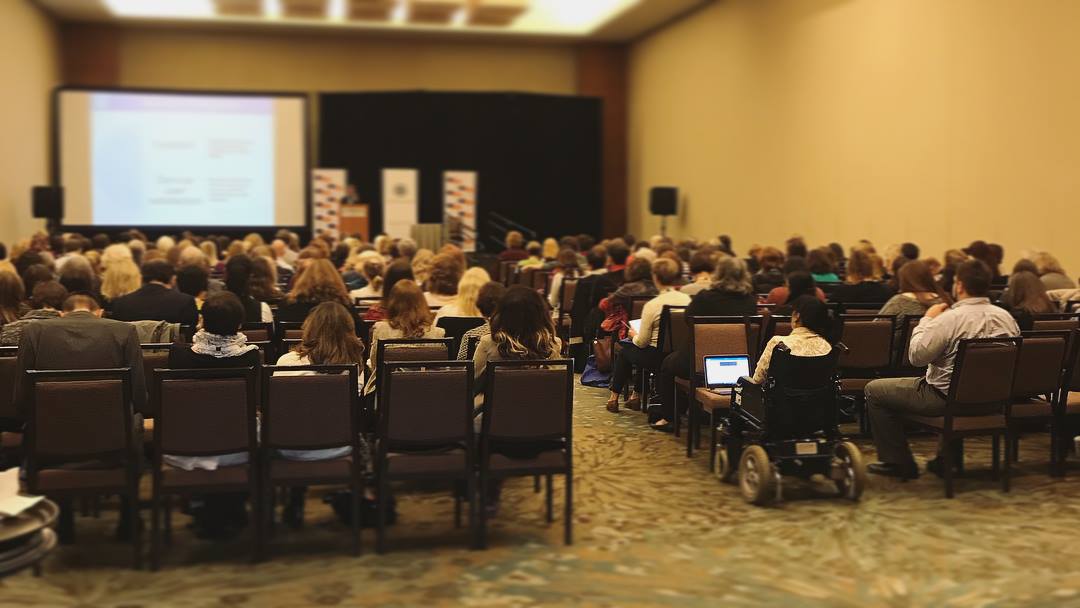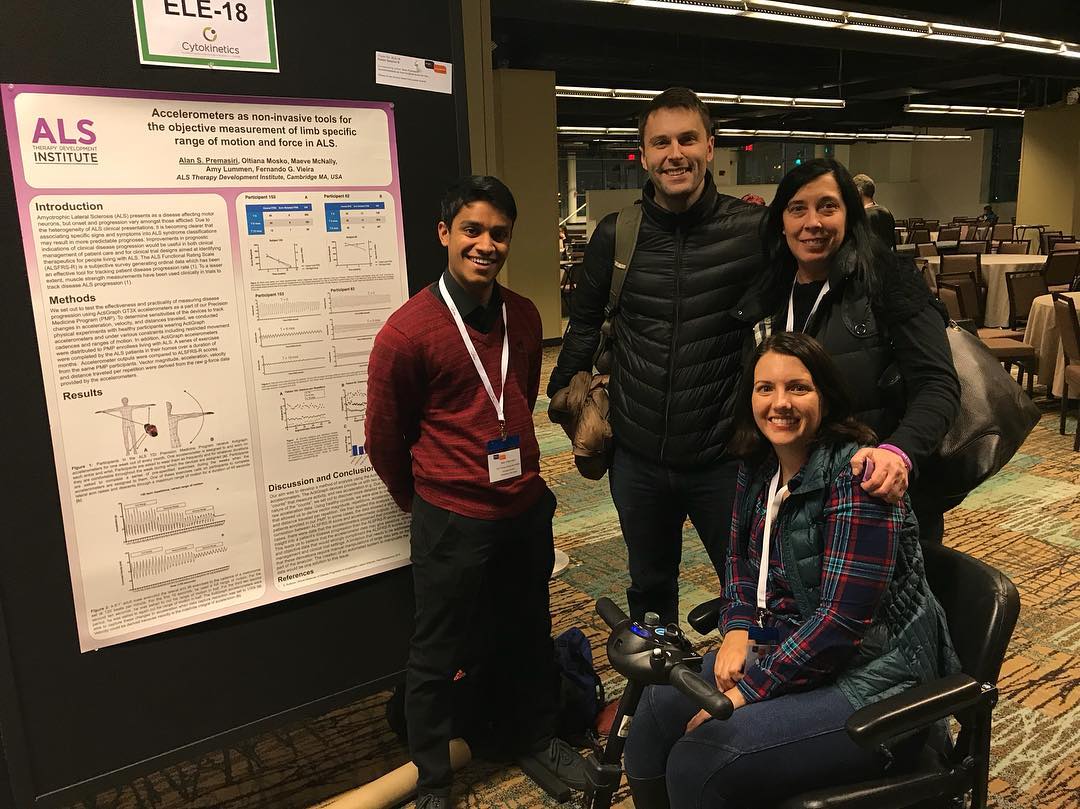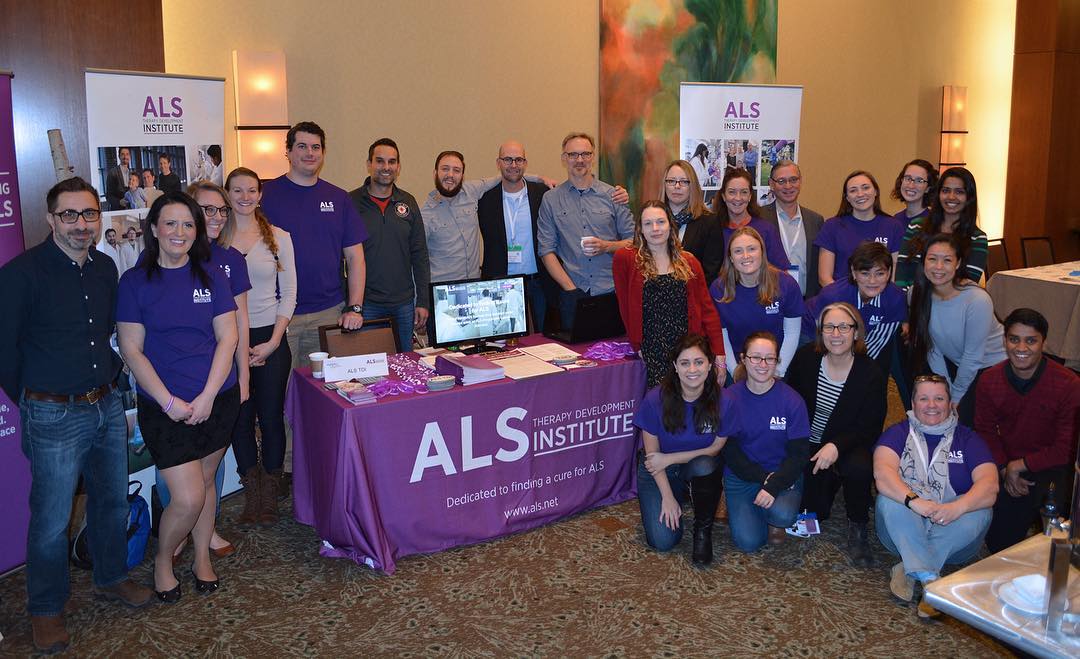 Over 1,500 people from around the world came together on December 8-10 in Boston, MA at the 28th International Symposium on ALS/MND to talk about progress being made in ALS/MND research. This was a record year for attendance overall but most importantly, this year saw the most attendees living with ALS than ever before. This was in part due to the launch of the ALS/MND Patient Fellows Program which was created to ensure that those living with ALS were given the opportunity to attend scientific meetings and conferences about ALS/MND. This year’s event was certainly richer for having people in the audience whose lives are directly affected by the research happening all over the world and giving them the opportunity to ask questions and participate in discussions. You can learn more about the ALS/MND Patient Fellows Program here.
Over 1,500 people from around the world came together on December 8-10 in Boston, MA at the 28th International Symposium on ALS/MND to talk about progress being made in ALS/MND research. This was a record year for attendance overall but most importantly, this year saw the most attendees living with ALS than ever before. This was in part due to the launch of the ALS/MND Patient Fellows Program which was created to ensure that those living with ALS were given the opportunity to attend scientific meetings and conferences about ALS/MND. This year’s event was certainly richer for having people in the audience whose lives are directly affected by the research happening all over the world and giving them the opportunity to ask questions and participate in discussions. You can learn more about the ALS/MND Patient Fellows Program here.
The symposium is organized annually by the Motor Neurone Disease Association (MNDA) of England, Wales and Northern Ireland and this year, the ALS Therapy Development Institute (ALS TDI) were co-hosts along with the ALS Hope Foundation. The event featured 23 sessions, each with 4-6 talks of 15-30 minutes in length covering biomedical and clinical research from around the world, along with two poster sessions with hundreds of presentations. This year, we were thrilled to have 11 scientists from ALS TDI present posters on the world stage at the Symposium. A full list of those posters can be found here.
The following recap includes some highlights with a focus on the clinical science sessions from the symposium. it is estimated that as many as 100,000 people with ALS participated in clinical trials or other research studies that scientists reported on at the Symposium this year. Each one of these people with ALS should be recognized for their individual contributions to finding effective treatments for ALS.

The Symposium opened with the annual award ceremony where the three co-founders of the Ice Bucket Challenge, Pete Frates, Pat Quinn and the late Anthony Senerchia were given the Humanitarian Award which recognizes those who have made a significant impact on the lives of those with ALS/MND internationally. The award was accepted on their behalf by Pete’s mom, Nancy Frates. Dr. Marka van Blitterswijk received the Instituto Paulo Gontijo (IPG) Award and Dr. Merit Cudkowicz was recognized with the Forbes Norris Award.
Disappointment as tirasemtiv fails to meet endpoints in phase 3 trial.
Earlier in 2017 we were hoping to celebrate the results from Cytokinetics’ phase 3 trial (VITALITY-ALS). Unfortunately, about a month before the symposium, we found out that tirasemtiv failed to meet its endpoints in that trial. While the data showed no safety issues, there were problems with tolerability, leading to high patient drop-out. Over the course of ten years, 1500 people living with ALS participated in studies on tirasemtiv.
Despite this setback, Cytokinetics is not giving up on their search for a treatment for ALS. They have built a new drug that aims to enhance muscle sensitivity to calcium, CK-107, and they are quickly enrolling people with ALS into a phase 2 clinical trial across more than two dozen different clinics. This drug is modified in a way in which to prevent it passing the blood brain barrier, which the company believes will reduce the opportunity for side effects that were seen in their previous drug’s trial.
It is important to note that more than 100 people with ALS are still accessing tirasemtiv through an open label extension trial. The company has committed to continuing to making tirasemtiv available to those that are enrolling in that open label trial for the foreseeable future, despite the trial missing its endpoints. This is an extraordinary step taken by Cytokinetics and generally speaking in the current field of ALS clinical trials.
AB Science to begin a phase 3 clinical trial in the US on masitinib
Dr. Jesus Mora from AB Science spoke about the latest data from the most advanced clinical trial in ALS at this time - masitinib. Masitinib is a potential treatment which aims to target macrophages, and prevent them from infiltrating the CNS/PNS where they can cause neuroinflammation and cell death. Overall, this trial has been more inclusive than most with only one third of people receiving the placebo and participants with a forced vital capacity (FVC) of 60% or greater were included. Those who took the active drug lost an average of 9.2 points on the ALSFRS-R over 48 weeks compared to those on the placebo who lost an average of 12.6 points suggesting a 27% slowing in disease progression with greatest impact showing in those who were earlier on in their disease. According to Dr. Mora, the phase 3 trial which took place in Europe, focused on “fast progressors” or those who lost more than 1.1 points per month on ALSFRS-R.
The data is currently being reviewed by the European Medicines Agency (EMA), the equivalent of the United States FDA, and we should know more in the first half of 2018. The company are currently preparing to recruit for a phase 3 confirmatory trial in the United States. Sign up to our clinical trials mailing list to receive updates.
Lessons learned following the approval of edaravone
The clinical session on day one finished with an address from Joseph Palumbo on the outcomes following the approval of edaravone in the US earlier this year. Palumbo noted differing levels of success for people trying to access the drug. For example, John’s Hopkins University reported around 100 people from their clinic were currently taking Radicava while the clinic at Emory University reported none. It was also noted that there are still a number of growing pains related to drug access with some doctors refusing to prescribe and some insurers not covering the costs of the drug, particularly if patients do not meet the criteria used in the clinical trials of edaravone.
Both Ibudilast and Rasagiline complete phase 2 trials
Dr. Ben Rix Brooks of Carolinas Health Care System presented data on trials testing ibudilast (MN-166) in ALS. This anti-inflammatory drug is most widely used in Japan for the treatment of asthma and stroke. Reporting on phase 2 trial, Dr. Rix showed some data to suggest that those taking the treatment responded slightly better according to their ALSFRS-R scores after six months and there was some positive response reported on ALSAQ-5 (a questionnaire which assesses quality of life in those living with ALS), however, there was no overly positive change in the treatment group and a longer study is needed to reinforce any data found.
Another drug which was presented on was Rasagiline. This drug is currently used as a treatment for early stage Parkinson’s disease. A large, European-based study completed a phase 2 trial with 250 people living with ALS. This trial demonstrated no significant difference between the treated and placebo arms on ALSFRS-R or vital capacity. However there is currently a US based trial ongoing at a different dose and we will likely hear results later this year.
Patient survey on the use of cannabis in ALS
Leslie Ryan of the ALS Association Rocky Mountain Chapter spoke the day before the symposium at the Allied Professionals Forum on cannabis use in people with ALS. Her group used a survey across 43 states in the US to gain more insight on how many people in the ALS community use cannabis, what type they use, how they administer it and whether those using it found it to have any effect on their disease symptoms or if they do not use cannabis or have never tried it, why not?
67% of respondents said they do not use cannabis, 5% said yes they had but had stopped and 30% do use cannabis to manage symptoms of ALS. Most people who reported not using cannabis reported to not do so because of personal choice or because it is illegal in their state. Others worry about being judged by people and doctor, losing health insurance.
57% of those who do use cannabis, reported it had a positive impact on their ability to complete daily tasks. 69% believe cannabis positively affects emotional ability to cope with disease progression and 91% believe it increased quality of life. The survey presented some interesting results but further investigation could provide us with more specific details on access, administration, types and specific impact of cannabis in people’s lives.
You can watch the presentation in full here.
Spatial analysis of people living with ALS and telehealth
Dr. Kevin Horton from the Centers for Disease Control and Prevention and the Agency for Toxic Substances and Disease Registry, gave a spatial analysis of those living with ALS in the United States, based on the ALS registry. He found that over 40% of people living with ALS on the registry lived 50 miles or more away from the closest Multidisciplinary ALS clinic (MDC) and around 25% live 100 miles or more from the closest clinic. This is one of the greatest challenges facing those living with ALS today. Without access to resources and a doctor’s care, it has been shown that those living with ALS suffer with a decrease in survival and lack of end-of-life care.
Delving deeper into this critical issue, Dr. Perrin, from the ALS Therapy Development Institute, gave a platform talk on the advances of the Precision Medicine Program (PMP) at ALS TDI.
Research has demonstrated that using telehealth tools such as accelerometers and voice recording devices, disease progression can be accurately tracked and recorded at home without making a long commute to a clinic to physically visit with a doctor. This expands the level of doctor accessibility to those living further away from clinics but also reduces the travel burden and cost for all people living with ALS. As part of ALS TDI’s Precision Medicine Program, trial participants have access to their own data and progression information 24/7 allowing them to measure whether their particular treatment plan is influencing their disease path. Dr. Perrin acknowledged that there while the Institute’s program was the first and has now produced results, that there are others out there and that the data from all of them should be unified whenever possible.
Hypermetabolism and ALS
Another finding which was presented at the Symposium was the issue of hyper metabolism in ALS. It has long been suspected that those living with ALS often suffer from hyper metabolism, meaning that they burn too much energy, and therefor lose weight at a faster rate than healthy controls. Dr. Frederik Steyn from the University of Queensland, Australia presented on his observational trial which was well matched in terms of disease versus healthy control group in terms of age and gender with 58 people in each group. He found that 40% of people living with ALS were burning more calories on average than those in the control group.
Twenty-four people in the hyper metabolic, disease category had a slightly faster progressing disease and usually have limb onset ALS as opposed to bulbar. The researchers found no relation to cognitive function in their study. While this is an interesting study and has confirmed many people’s experience with faster weight loss in ALS, deeper study is needed to look at how doctors can target this aspect of the disease with their patients.
The multi day symposium closed with an address from Dr. Robert Brown on the lessons learned from and the future of the SOD1 model in ALS research. The Shay Rishoni Patient Impact award went to Bernardus Muller and Robbert Jan Stuit, who founded Project MinE, a large scale research initiative to better understand the genetic basis of ALS. The session closed with an invitation to delegates to join the 29th International Symposium on ALS/MND in Glasgow in 2018.
If you’d like to hear more about the 28th International Symposium on ALS/MND, watch Robert Goldstein’s webinar here.
